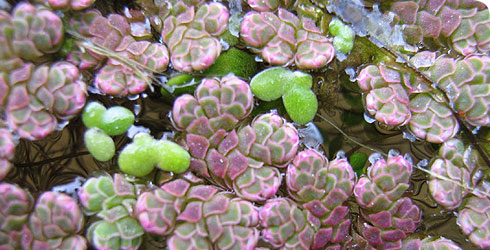Taxonomy
Azolla can be placed in its own family, Azollaceae, but is often included with Salvinia in the family Salviniaceae. Salviniaceae and Marsileaceae (Marsilea, Pilularia and Regnellidium) form a monophyletic group of water ferns, which are all heterosporous, ie. produce two kinds of spores, large female megaspores and small male microspores.
Many fossil species of Azolla are known from the Upper Cretaceous. Today there are only 6 or 7 species in this genus.
Azolla species are difficult to identify because high magnification is required to see the distinguishing characters clearly. In addition, the plants are often sterile and thus lack most of the features essential for identification. This has led to many misidentifications, confused taxonomy and thus uncertainty over species distributions.
Morphology
The small plants of Azolla filiculoides are prostrate, with branching thread-like horizontal stems generally up to 5cm long.
Numerous unbranched roots up to 5cm long hang below the plant, arising from the underside of the stem at branching points.
The tiny leaves (no more than 1.5 x 2.5mm in size) are alternately arranged in 2 rows on the upper side of the stem and overlap like roof tiles.
Each leaf is divided into 2 lobes:
- the upper lobe is green, several cells thick and bears numerous single-celled papillate hairs
- the upper lobe has a cavity in which the thread-like blue-green alga (cyanobacterium) Anabaena azollae lives in symbiosis
- the lower lobe is more-or-less colourless and only one cell thick except at the base
Spores are produced inside sporocarps. The sporocarps are borne in pairs (sexes the same or different) on the first leaf of each branch, the lower lobe forming the sporocarp and the upper lobe forming a false indusium over the sporocarp:

Azolla filiculoides 2 large microsporocarps with 1 small megasporocarp with dark indusium cap. Photo credit H Taylor.
- megasporocarps (female; about 0.5mm diameter) contain just one megasporangium, inside which a single megaspore develops
- as the megaspore matures, floats develop above it, topped with a colony of cyanobacteria and covered by a dark conical indusium; collectively this is known as the ‘megaspore apparatus’
- microsporocarps (male; about 2mm diameter) contain numerous sporangia, each containing 64 microspores
- the microspores are clumped together with other tissue in massulae that bear barbed hairs called glochidia
Look-alikes
Azolla caroliniana and A. mexicana are very similar to A. filiculoides. Although A. filiculoides is the common species in western Europe, both the others have been recorded, though some of the identifications are questionable. All three species are native in the Americas.
They differ principally in:
- the number of cells in the hairs on the upper leaf lobes - A. filiculoides has single-celled hairs whereas those of A. caroliniana and A. mexicana have at least 2 cells (light microscope required)
- the nature of the surface of the megaspore (female spore) – A. filiculoides has megaspores with a warty surface, while those of A. caroliniana and A. mexicana are not warty (scanning electron microscope needed)
Toolbox
Glossary
Eutrophic
Rich in nutrients.
Glochidia
Barbed hairs on massulae.
Heterosporous
Having 2 kinds of spores.
Indusium
Tissue that protects the sporangia.
Massula
Mass of microspores and associated tissue (term is also applied to female ‘floats’ in the megaspore apparatus).
Megaspore
Female spore.
Microspore
Male spore.
Monophyletic
Descended from a single common ancestor.
Papilla
Minute projection on the surface of a leaf.
Prothallus
Fern gametophyte.
Sporangium
Spore capsule.
Sporocarp
Structure that contains the sporangia.
Symbiont
An organism in a close and long-term association with another species.
